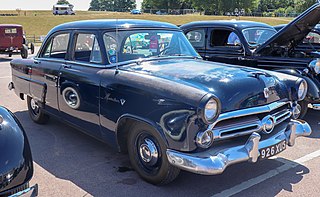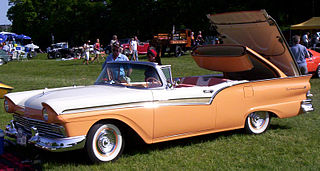
The Mercury Comet is an automobile that was produced by Mercury from 1960–1969 and 1971–1977 — variously as either a compact or an intermediate car. In its first two years, it was marketed as the "Comet" and from 1962 as the "Mercury Comet".

The Ford Galaxie is a car that was marketed by Ford in North America from the 1959 to 1974 model years. Deriving its nameplate from a marketing tie-in with the excitement surrounding the Space Race, the Galaxie was offered as a sedan within the full-size Ford range throughout its production run. In the full-size segment, the model line competed against the Chevrolet Impala and Dodge Polara.

The Ford Ranchero is a coupe utility that was produced by Ford between 1957 and 1979. Unlike a standard pickup truck, the Ranchero was adapted from a two-door station wagon platform that integrated the cab and cargo bed into the body. A total of 508,355 units were produced during the model's production run. Over its lifespan it was variously derived from full-sized, compact, and intermediate automobiles sold by Ford for the North American market.

The Ford Country Squire is a series of full-size station wagons that were assembled by American automaker Ford. Positioned as the top-level station wagon of the Ford division, the Country Squire was distinguished by woodgrain bodyside trim. From 1950 through the 1991 model years, eight generations of the Country Squire were produced. Following the discontinuation of Edsel Bermuda, Mercury marketed the Mercury Colony Park as a divisional counterpart of the Country Squire, sharing bodywork and trim while the Mercury was not available with a six cylinder engine and was more expensive due to the optional equipment on the Ford that was standard on the Mercury.

The Ford Mainline is an automobile which was produced by Ford in the United States in the models years 1952 to 1956. It was introduced as the base trim level of the 1952 Ford range below the Customline and Crestline models. The Mainline retained its position in the redesigned 1955 Ford range but was discontinued for the 1957 model year when the Ford Custom became the new base model.

The Ford LTD is a range of automobiles manufactured by Ford for the 1965 to 1986 model years. Introduced as the highest trim level of the full-size Ford model range, the LTD moved the Ford range upmarket, offering options and features previously reserved for Mercury and Lincoln vehicles. For much of its production life, the LTD competed against the Chevrolet Caprice ; the Mercury Marquis served as its divisional counterpart from 1967 until 1986.

Meteor was a marque of automobiles offered by Ford Motor Company of Canada from 1949 to 1976. The make was retired for the 1962 and 1963 model years, when the name was used for the Mercury Meteor sold in the United States. It succeeded the Mercury 114, a Canadian-market Mercury based on the Ford, the "114" name being taken from the car's wheelbase.

The Ford Custom is an automobile which was produced by Ford in the United States, Canada and Australia in certain years from 1949 to 1981.

The Ford Fairlane is an automobile model that was sold between the 1955 and 1970 model years by Ford in North America. Taking its name from the Dearborn, Michigan estate of Henry Ford, the Fairlane nameplate was used for seven different generations of vehicles. Through its production, the model line would be marketed in a wide variety of body styles, including two-door and four-door sedans, two-door and four-door hardtops, station wagons, and both traditional and retractable-hardtop convertibles.

The Ford Fairlane and LTD are full-sized luxury vehicles produced in a series of models by Ford Australia between 1959 and 2007.

The Ford LTD Crown Victoria is a line of full-size cars that was manufactured and marketed by Ford from the 1980 to 1991 model years. Deriving its name from the Ford Fairlane coupe of 1955–1956, the LTD Crown Victoria served as the flagship of the Ford LTD model range in North America. Serving as the Ford counterpart of the Mercury Grand Marquis, the model line was offered as a two-door and a four-door sedan and a five-door station wagon.

The Mercury Meteor is an automobile that was produced by Mercury from the 1961 to 1963 model years. Adopting its nameplate from the namesake Ford of Canada brand, the Meteor was introduced as the base-trim full-size Mercury sedan, while the compact Mercury Comet shared a naming convention associated with the ongoing Space Race of the early 1960s. Slotted below the Mercury Monterey, the Meteor was the Mercury counterpart of the Ford Fairlane.

The Dodge Custom 880 is an automobile that was marketed by Dodge from 1962 through the end of the 1965 model year. It was positioned as Dodge's product offer in the mid-price full-size market segment and to help fill the void in Chrysler's lineup left by the discontinuation of DeSoto in 1961. A cheaper version, the Dodge 880, was also offered for 1963 and 1964.

The Ford Falcon is a model line of cars that was produced by Ford from the 1960 to 1970 model years. Though preceded by the Rambler American, the Falcon was the first compact car marketed by the Big Three American manufacturers.

The Ford Customline is an automobile model that was sold between 1952 and 1956 by Ford in North America.

The Ford line of cars was again refreshed for 1952, although remaining similar to the all-new 1949 Fords. This time, curved one-piece windshield glass joined a new "Mileage Maker" straight-6 engine with 101 hp. The 226 CID (3.7 L) L-head straight-6 was replaced by an overhead valve 215 CID (3.5 L) Mileage Maker with 101 hp (75 kW), while the old 239 CID (3.9 L) Flathead V8 remained with 110 hp (82 kW). This design would continue through the 1954 model year, with an updated design offered in 1955.

The 1955 Ford is an automobile which was produced by Ford in the United States for the 1955 model year and, in revised form, for the 1956 model year. A new design would be offered in 1957.

The mainstream Ford line of cars grew substantially larger for 1957, a model which lasted through 1959. The Crown Victoria with its flashy chrome "basket handle" was no more, and the acrylic glass-roofed Crown Victoria Skyliner was replaced by a new model, the retracting-roof hardtop Skyliner.

Leading into the 1950s, Ford, along with many other top of the market car manufacturers were capitalizing on the post war boom. Many new advancements in technology and products were being developed during this time that allowed for cars going into the future to have features never seen before or features that were not normal until now. The automatic window, for example, was a new feature that made Americans see their current cars as outdated and technologically behind. The 1960s were one of the best eras for the production of cars, as the war between Ford and Chevrolet heated up and produced some of the most classic and recognizable cars in America still to this day.
Full-size Ford is a term adopted for a long-running line of Ford vehicles with a shared model lineage in North America. Originating in 1908 with the Ford Model T, the line ended in 2019 with the Ford Taurus, as Ford withdrew from the full-sized sedan segment in North America. Across 111 years, 15 generations, and over 60 million examples of the model line were produced across over 50 model nameplates. By contrast, the longest-running single nameplate worldwide is the Chevrolet Suburban, in use since the 1935 model year.


























